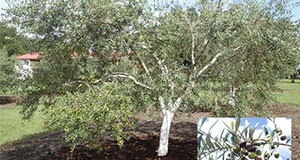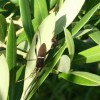 Olives have great potential as a landscape ornamental and may also provide opportunities for home fruit production. However, as a relatively new commercial crop to Florida, the cultural requirements of these trees are not completely known and research is ongoing to understand how to manage them for plant health and fruit yield as well as to make recommendations on varietal selections best suited to the southeastern region of the United States. This 5-page fact sheet includes culture and management information, selected references, and a table listing a selection of olive cultivars currently available in the U.S. Written by Mack Thetford, Jennifer L. Gillett-Kaufman, Michael J. Mulvaney, and published by the UF Department of Environmental Horticulture, February 2015.
Olives have great potential as a landscape ornamental and may also provide opportunities for home fruit production. However, as a relatively new commercial crop to Florida, the cultural requirements of these trees are not completely known and research is ongoing to understand how to manage them for plant health and fruit yield as well as to make recommendations on varietal selections best suited to the southeastern region of the United States. This 5-page fact sheet includes culture and management information, selected references, and a table listing a selection of olive cultivars currently available in the U.S. Written by Mack Thetford, Jennifer L. Gillett-Kaufman, Michael J. Mulvaney, and published by the UF Department of Environmental Horticulture, February 2015.
http://edis.ifas.ufl.edu/ep515
Tag: Olive Trees
Plagas y Hongos Identificados en Olivos (Olea europea) en Florida
 La producción de olivo o aceitunas (Olea europea) en Florida ha aumentado en los últimos años. La disponibilidad de árboles en los viveros de plantas ha aumentado y muchos residentes los compran para plantarlos en su patio. Afortunadamente, los olivos son una especie relativamente resistente a muchas plagas, pero en ocasiones surgen invasores que pueden causar daños significativos. Algunos patógenos también pueden infectar los olivos y causar enfermedades, reducir los rendimientos o arruinar la apariencia estética de los árboles. Siguiendo las prácticas de cultivo apropiadas para olivos podemos reducir las probabilidades de perder árboles por plagas y enfermedades. Una encuesta realizada con productores de aceitunas en Florida durante el año 2014 identificó las plagas y enfermedades descritas en este documento.
La producción de olivo o aceitunas (Olea europea) en Florida ha aumentado en los últimos años. La disponibilidad de árboles en los viveros de plantas ha aumentado y muchos residentes los compran para plantarlos en su patio. Afortunadamente, los olivos son una especie relativamente resistente a muchas plagas, pero en ocasiones surgen invasores que pueden causar daños significativos. Algunos patógenos también pueden infectar los olivos y causar enfermedades, reducir los rendimientos o arruinar la apariencia estética de los árboles. Siguiendo las prácticas de cultivo apropiadas para olivos podemos reducir las probabilidades de perder árboles por plagas y enfermedades. Una encuesta realizada con productores de aceitunas en Florida durante el año 2014 identificó las plagas y enfermedades descritas en este documento.
This 6-page fact sheet was written by Jennifer L. Gillett-Kaufman, Sandra A. Allan, Jonael H. Bosques-Méndez, and Lyle J. Buss; translated into Spanish by Jonael H. Bosques Méndez, and published by the UF Department of Entomology and Nematology, September 2014.
http://edis.ifas.ufl.edu/in1052
Pests and Fungal Organisms Identified on Olives (Olea europaea) in Florida
 Olive production in Florida has increased over the last few years. As trees become available in nurseries many homeowners are planting them in their landscapes. Fortunately, olives are a relatively pest-free species, but some occasional invaders can be a nuisance or cause lasting harm. A few plant pathogens that may infect olives also can lead to a decline in overall plant health, fruit yield, or the visual appearance of plants. Following correct cultural practices when growing olives can reduce your chances of tree loss from pests and diseases. A survey of olive production and interviews with Florida growers in 2014 identified the pests and diseases described in this 5-page fact sheet, written by Jennifer L. Gillett-Kaufman, Sandra A. Allan, Jonael H. Bosques-Mendez, and Lyle J. Buss, and published by the UF Department of Entomology and Nematology, September 2014.
Olive production in Florida has increased over the last few years. As trees become available in nurseries many homeowners are planting them in their landscapes. Fortunately, olives are a relatively pest-free species, but some occasional invaders can be a nuisance or cause lasting harm. A few plant pathogens that may infect olives also can lead to a decline in overall plant health, fruit yield, or the visual appearance of plants. Following correct cultural practices when growing olives can reduce your chances of tree loss from pests and diseases. A survey of olive production and interviews with Florida growers in 2014 identified the pests and diseases described in this 5-page fact sheet, written by Jennifer L. Gillett-Kaufman, Sandra A. Allan, Jonael H. Bosques-Mendez, and Lyle J. Buss, and published by the UF Department of Entomology and Nematology, September 2014.
http://edis.ifas.ufl.edu/in1046
EENY113/IN270 Olive Fruit Fly, Bactrocera oleae (Rossi) (Insecta: Diptera: Tephritidae)
Revised! EENY-113, a 4-page illustrated fact sheet by H. V. Weems and J. L. Nation, is part of the Featured Creatures collection. It describes this serious pest of olives in the Mediterranean — distribution, identification, life history and habits, hosts, and management procedures. Includes references. Published by the UF Department of Entomology and Nematology, July 2009.
http://edis.ifas.ufl.edu/IN270